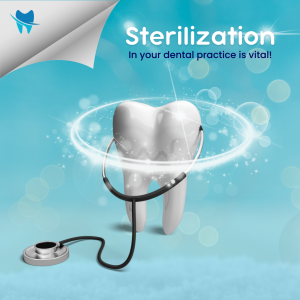The importance of sterilization when running a dental practice.
Using the right dental equipment is vital to running a successful dental practice.
VAUGHAN, ONTARIO, CANADA, May 26, 2022 /EINPresswire.com/ -- Sterilization is important when running a dental practice.This is because dental equipment can harbor bacteria and other microorganisms that can be harmful to patients. Sterilization helps to ensure that dental equipment is free of these contaminants. There are various methods of sterilization, such as autoclaving, which uses high temperature, pressure and time to kill microorganisms. Proper sterilization of dental equipment is essential to providing safe care for patients.
There are four key stages of dental sterilization:
1. Cleaning: This stage removes visible dirt and debris from dental instruments. By using hand scrubbing with a surfactant, detergent, and water. Or using equipment aided by a chemical agent or detergent such as an ultrasonic cleaner or instrument washer. Instruments must be cleaned before they can be properly sterilized.
2. Preparation and packaging. Water is used to any chemical or detergent residue. When using an instrument washer, this process is automated. Instruments are packaged in materials that prevent the instrument from being directly contaminated once sterile, such as pouches and wrapping
3. Sterilization: This stage uses high temperature, pressure and time to destroy all microorganisms, including bacteria spores.
4. Storage: This stage ensures that sterilized instruments are kept clean and ready for use. Proper storage prevents recontamination of sterile instruments.
Cleaning, Preparation and Packaging and sterilization are all important steps in the dental sterilization process.
People may ask about the multiple stages in the Dental sterilization process. What are they and what dental equipment can help you along the way?
The first stage is cleaning the equipment of gross debris. This can be done by hand scrubbing, a ultrasonic cleaner or instrument washer. The second stage is preparation (rinsing/drying) and packaging. The third stage is sterilizing the equipment. This is done with an autoclave using high temperature, pressure and time/. The fourth stage is storing the equipment using a designated sterile area with physical breaks from the previous stages.
Cleaning, preparing/packaging, and sterilizing dental equipment is essential to providing safe care for patients. There are various methods of sterilization, such as autoclaving, which uses high temperatures, pressures, and time. Proper sterilization of dental equipment is essential to providing safe care for patients.
The equipment used in dental sterilization is called an autoclave. Autoclaves use steam under pressure to raise the temperature and pressure inside the chamber to a level and for a period that is lethal to microorganisms. The most important thing to remember when using an autoclave is to follow the manufacturer’s instructions for loading and operating the machine. Improper use of an autoclave can result in ineffective sterilization of instruments and put patients at risk for infection.
When used correctly, autoclaves are a very effective method of sterilization. However, they are not foolproof. There is a chance that bacteria or other microorganisms could survive the sterilization process if the correct class and cycles are not used. It is important to take steps to prevent contamination of sterile instruments during storage.
Some examples of contamination are: Chemical contamination can occur when liquids or chemicals encounter sterile instruments or materials. Physical contamination can occur when dust, dirt, or other debris come into contact with sterile instruments or materials. Biological contamination can occur when microorganisms (such as bacteria) come into contact with sterile instruments or materials.
What are the 4 stages of sterilization?
1. Receiving and cleaning
2. Preparation and packaging
3. Sterilization
4. Sterile Clean Storage
Why is it important to have the best dental equipment?
It is important to have the best dental equipment because it helps to ensure that instruments and materials are kept clean and free of contaminants. When choosing a sterilizer, it is important to select one that is the appropriate class and volume for your needs. It is also important to refer to your instrument manufacturers IFUs (instructions for use) to ensure the proper cycle and parameters are selected and met.
Eric Horwood
Specialty Dental
+1 905-669-2197
email us here
Visit us on social media:
Facebook
Legal Disclaimer:
EIN Presswire provides this news content "as is" without warranty of any kind. We do not accept any responsibility or liability for the accuracy, content, images, videos, licenses, completeness, legality, or reliability of the information contained in this article. If you have any complaints or copyright issues related to this article, kindly contact the author above.

